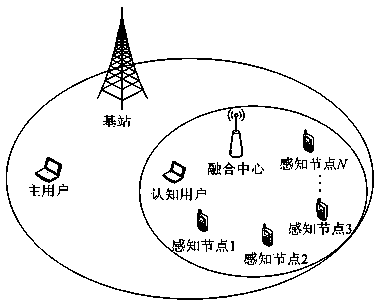Method for cooperative spectrum detection based on node recognition
A collaborative spectrum and detection method technology, applied in the field of cognitive network spectrum sensing, can solve the problems of decreased data transmission efficiency, reduced reliability, and increased communication system overhead
- Summary
- Abstract
- Description
- Claims
- Application Information
AI Technical Summary
Problems solved by technology
Method used
Image
Examples
Embodiment Construction
[0035] The present invention will be further described below in conjunction with the accompanying drawings and specific embodiments.
[0036] Such as figure 1 , in a cognitive wireless network including at least one primary user, N cognitive users and at least one fusion center, the cognitive users perform spectrum detection on the surrounding environment, and there are two hypotheses H for the detection results 1 and H 0 , where H 1 Indicates that the spectrum of the detection section in the network is busy, and the primary user is using this section of spectrum; H 0 Indicates that the spectrum of the detection section in the network is idle, and the primary user is not using this section of spectrum. Spectrum detection of the i-th cognitive user (sensing node), i=1...N, can be modeled as a binary hypothesis testing problem
[0037] H 1 : ...
PUM
 Login to View More
Login to View More Abstract
Description
Claims
Application Information
 Login to View More
Login to View More - R&D
- Intellectual Property
- Life Sciences
- Materials
- Tech Scout
- Unparalleled Data Quality
- Higher Quality Content
- 60% Fewer Hallucinations
Browse by: Latest US Patents, China's latest patents, Technical Efficacy Thesaurus, Application Domain, Technology Topic, Popular Technical Reports.
© 2025 PatSnap. All rights reserved.Legal|Privacy policy|Modern Slavery Act Transparency Statement|Sitemap|About US| Contact US: help@patsnap.com



